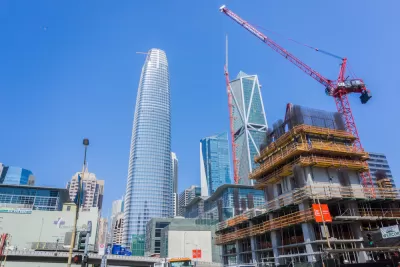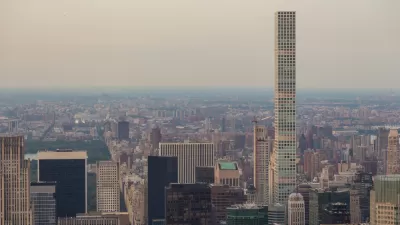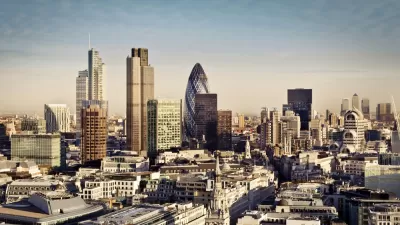Of the city’s newest, tallest building John King writes, “[it’s] as if the creators were so busy being tasteful they forgot that big buildings can be fun."

This week, the Salesforce Tower in San Francisco “quietly opened for business,” and John King, architecture critic for the San Francisco Chronicle, is only very mildly impressed.
“The 1,070-foot shaft, with its tapered form of metal and glass, is a well-tailored behemoth. Immense but understated. Overwhelming yet refined. A study in thick-walled minimalism that seems to hover more than soar.
All of which makes for a nuanced tower, conscientious and self-assured even as it reorients the skyline and redefines San Francisco’s visual image. But there’s also an air of detachment, as if the creators were so busy being tasteful they forgot that big buildings can be fun.”
In its many years under construction, the Salesforce Tower easily surpassed the height of San Francisco's now-second-tallest building, the TransAmerica Pyramid. That building was controversial in its own time but, as King previously wrote, has an iconic quality that is arguably lacking in the city's newest skyscraper.
One of a new crop of very tall buildings on the West Coast, naming rights to the Salesforce Tower—originally known as the Transbay Tower—were bought by a cloud-computing company that is a major employer in San Francisco and agreed to lease 36 of the available 61 floors.
The symbolism of a tech company looming over the entire city is not lost on observers, King has reported. And buildings of increasing heights have long been used to establish dominance in San Francisco, David Streitfeld recently wrote in The New York Times, adding of the Salesforce building, “The tower is not beautiful but is impossible to ignore.”
King reports similarly tempered comments from one of the principle architects, Cesar Pelli, who said of the tower that its was meant to be “very tall, very big, but still polite.’”
FULL STORY: Salesforce Tower - underwhelming despite its size

Alabama: Trump Terminates Settlements for Black Communities Harmed By Raw Sewage
Trump deemed the landmark civil rights agreement “illegal DEI and environmental justice policy.”

Planetizen Federal Action Tracker
A weekly monitor of how Trump’s orders and actions are impacting planners and planning in America.

The 120 Year Old Tiny Home Villages That Sheltered San Francisco’s Earthquake Refugees
More than a century ago, San Francisco mobilized to house thousands of residents displaced by the 1906 earthquake. Could their strategy offer a model for the present?

In Both Crashes and Crime, Public Transportation is Far Safer than Driving
Contrary to popular assumptions, public transportation has far lower crash and crime rates than automobile travel. For safer communities, improve and encourage transit travel.

Report: Zoning Reforms Should Complement Nashville’s Ambitious Transit Plan
Without reform, restrictive zoning codes will limit the impact of the city’s planned transit expansion and could exclude some of the residents who depend on transit the most.

Judge Orders Release of Frozen IRA, IIJA Funding
The decision is a victory for environmental groups who charged that freezing funds for critical infrastructure and disaster response programs caused “real and irreparable harm” to communities.
Urban Design for Planners 1: Software Tools
This six-course series explores essential urban design concepts using open source software and equips planners with the tools they need to participate fully in the urban design process.
Planning for Universal Design
Learn the tools for implementing Universal Design in planning regulations.
Clanton & Associates, Inc.
Jessamine County Fiscal Court
Institute for Housing and Urban Development Studies (IHS)
City of Grandview
Harvard GSD Executive Education
Toledo-Lucas County Plan Commissions
Salt Lake City
NYU Wagner Graduate School of Public Service




























